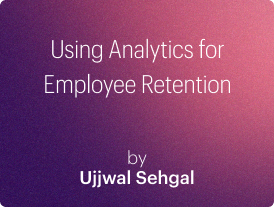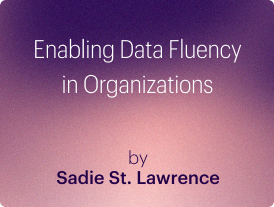Why the need for data upskilling?
In the past few years, the growth of AI solutions and applications across industries has been meteoric and almost become a necessity to gain an edge in any industry. However, there has been growing unease among the workforce with the eternal question – will AI/ML or the use of bots replace human effort?
In the face of this reluctance of teams to adopt data analytics, global business leaders are faced with a dilemma – how to retain employees without giving up on AI, data analytics, automation, or robotics?
This is where upskilling your workforce is important, especially in AI and data analytics.
As per a recent Gartner report, only 50% of enterprise strategies list data analytics as a critical skill set for delivering enterprise-level value. A Deloitte survey verifies that only 20% of executives believe their institutions have the skills to operate in an AI-enabled digitized world.
So how do you go about making your team ‘Data Fluent’? Here is how you can get started with data upskilling in your organization.
Stage 1: Assessing the current and identifying the desired future state.
TLet’s understand with the example of a Canadian Crown Corporation (CCC) which assessed the skill gaps it needed to fill. Here are five steps to make a well-rounded assessment of your team’s current state and future needs.


Stage 2: Invest, develop, and deliver effective training
Before the pandemic, learning was usually confined to classroom environments. Since then, new forms of learning have gained acceptance. Employees have more options available. These include self-studying, informal learning, and e-learning through self-paced online courses. The benefit of using such non-classroom environments is that learners can participate whenever, wherever, and however they feel like it.
Practical application is essential to the entire learning process. It allows us to acquire and retain new knowledge. The Kolb Model of Experiential Learning has consistently helped learners using a cyclic pattern. The following figure shows us how the experiential learning model works.

The focus in experimental learning should be on practice, real-world application, and repetition. Institutions and organizations can expect to derive long-term value from their investments in data upskilling their workforce. In fact, experiential learning tends to create self-motivation among learners. Organizations can further incentivize upskilling.
For e.g., Deloitte has provided financial benefits to professionals who obtain upskilling certificates. LinkedIn offers badges, thus allowing learners to showcase their skills. Anheuser-Busch InBev and Labatt use rotation programs to instil a sense of continuous learning among learners/employees. New recruits are rotated through different functions, so they develop a broader understanding of the business and pick up vital skills.
Stage 3: Making learning ‘stick’
Now that your workforce is learning some new AI-related skills, how do you make sure this is sustainable? To solve this problem, we must look at our respective organizations from three perspectives – people, technologies, and processes.
People – Is your organization ready for AI and the AI-powered workforce?
Technology – Does your organization have the infrastructure to support AI talent and transformation?
Process – Are you ready to embrace a new way of working?
At a glance
Here are some of the things to keep in mind as a business leader if you intend to upskill your team/workforce.



